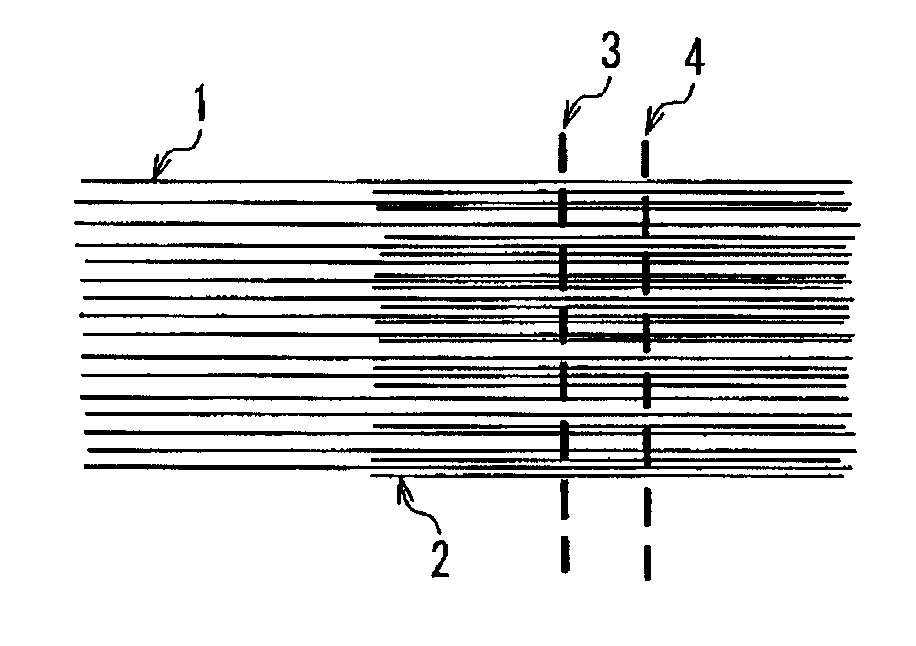Hair extension, hair accessory using the same and method for producing hair extension
a hair extension and hair accessory technology, applied in the field of hair extension, can solve the problems of lack of voluminous hair extension, inability to obtain puffy look and touch, and achieve the effect of puffing hair
- Summary
- Abstract
- Description
- Claims
- Application Information
AI Technical Summary
Benefits of technology
Problems solved by technology
Method used
Image
Examples
examples
[0061]Hereinafter, the present invention will be specified with reference to Examples. It should be noted that the present invention will not be limited to the Examples.
[0062]Evaluation methods used in Examples of the present invention and the Comparative Examples are described below.
[0063](Strength and Elongation)
[0064]Tensile strength and elongation of fibers were measured by use of a tensile-compression tester (INTESCO Model201 supplied by INTESCO. Co., Ltd.). A fiber 40 mm in length was picked up and the both end parts of the fiber, each 10 mm, were sandwiched with paperboards (thin paper) on which a double-sided adhesive tape had been stuck. The fiber was air-dried overnight to prepare a specimen 20 mm in length. The specimen was attached to the tester, and subjected to a test under conditions of temperature of 24° C., humidity of not more than 80%, loading of 1 / 30 gF×fineness (denier), and tensile rate of 20 mm / min. so as to measure the tensile strength and elongation at ruptu...
examples 1-13
[0104]Example 1-13 relate to experiments concerning the process-A. The fibers shown in Table 1 were blended respectively as the main fibers and the root fibers at the ratios as shown in Table 3 below, and integrated by sewing with a three-head machine for wig production in the manner as shown in FIG. 1. Later, the integrated fibers were subjected to heat treatments at temperatures as shown in Table 3 below so as to obtain the hair extensions of Examples 1-13. Table 3 shows the results of crimp evaluation 1, the crimp evaluation 2, the voluminousness, the comprehensive evaluation and the styling property evaluation for the thus obtained hair extensions. The differences in heat shrinkage rates as shown in Table 3 were calculated based on the heat shrinkage rates of respective fibers listed in Table 2. Namely, differences in the heat shrinkage rates between the fibers used for the main fibers and the fibers used for the root fibers at predetermined heat treatment temperature were calcu...
example 14
[0108]Examples 14-18 relate to experiments for the process-B. In each of these Examples, the main fibers were the fibers ADR as shown in Table 1, and the root fibers were prepared by treating the fiber ADE as shown in Table 1 at 90° C. for 30 minutes in a convention oven so as to crimp the fibers. The main fibers and the root fibers were blended at the ratio as shown in Table 4, which were sewn with a three-head machine for wig production in the manner as shown in FIG. 1, thereby obtaining hair extensions. Table 4 shows the results of the crimp evaluation 2, the voluminousness, the comprehensive evaluation and the styling property of the obtained hair extensions. The differences in the heat shrinkage rates as shown in Table 4 were calculated on the basis of the heat shrinkage rates of respective fibers in Table 2 similarly to Examples 1-13.
[0109]In Examples 14-18, the voluminousness was evaluated in the following manner. A hair extension was produced in the above-mentioned method wh...
PUM
 Login to View More
Login to View More Abstract
Description
Claims
Application Information
 Login to View More
Login to View More - R&D
- Intellectual Property
- Life Sciences
- Materials
- Tech Scout
- Unparalleled Data Quality
- Higher Quality Content
- 60% Fewer Hallucinations
Browse by: Latest US Patents, China's latest patents, Technical Efficacy Thesaurus, Application Domain, Technology Topic, Popular Technical Reports.
© 2025 PatSnap. All rights reserved.Legal|Privacy policy|Modern Slavery Act Transparency Statement|Sitemap|About US| Contact US: help@patsnap.com



